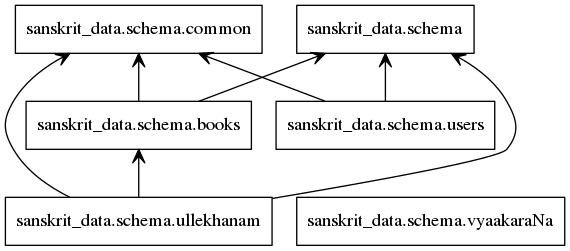sanskrit_data.schema¶
Intro¶
schema package contains modules which define various modules describing various classes for storing Sanskrit data, and their corresponding JSON schema.
Usage tips:
- Picking or defining the data container class.
- At the base of every such data container class is the common.JsonObject class.
- You can define such a class yourself, in your own package (Example here.).
- Enabling (de)serialization (if one has defined a data container class in a new module file)
- One needs to update
json_class_index- see the comment there for details.
- One needs to update
Data design¶
General principles¶
- We want data to be stored and communicated between programs in a popular, extensible format - we want to take advantage of existing technologies to the maximum possible extant and not waste time reinventing associated (de)serialization, validation and other libraries.
- But this does not prevent the data from being presented in a different format for human consumption.
While designing the JSON data-model:
- Type-hint in JSON should be jsonClass (a language-independent name we’ve picked).
- Try to avoid field-names which conflict with programming language keywords. (Eg. Prefer “source_type” to “type”).
- In general, use camelCase or underscore_case for field names - both are fine. Where romanized (potentially mixed case) sanskrit words are used, the latter is the superior convention.
- Where field names and values are to be automatically rendered into
various scripts, as in case of sanskrit vyAkarana jargon (eg:
vibhakti, lakAra), we prefer SLP1 transliteration (“viBakti”,
“lakAra”).
- PS: Convenient transliteration modules are available in various languages: please see them listed here.
- A transliteration map for reference.
- When in doubt, keep fields optional.
Python data containers and utilities¶
- For each JSON schema, we have a python class, at the root of which there is the generic JsonObject class with a lot of utilities. We define a hierarchy of classes so as to share validation and other code specific to certain data classes.
- Separate Database-specific elements through an interface. We should be able to easily switch to a different database.
- The schema class field contains the corresponding JSON schema. An introductory video describing how such schema are to be read.
Books and annotations¶
Please refer to books and ullekhanam .

